Yaku-Cedars in Essen (No. 34)
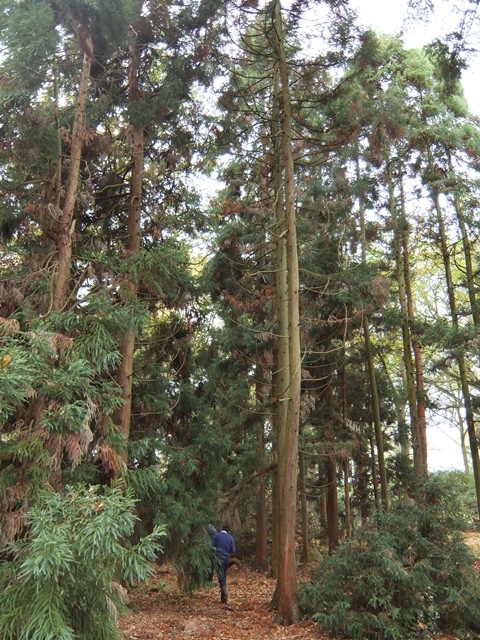 When living in a foreign country, we encounter people with a deep affinity towards Japan and we discover goods and facilities deeply related with Japanese culture in surprising places. As I mention in this column frequently, exchanges between Japan and Belgium in the private sector and local governments have deepened more than imagined. However, nothing surprised me more than when I was invited by a Belgian friend who lives in the small town of Essen located on the border with The Netherlands, 90km north of Brussels, and where I saw a copse of Yaku-Cedar trees. The Island Yakushima in the south of the Japanese archipelago is famous for its Japanese cedars of over 1000 years old, which have been designated UNESCO world heritage. At the residence of my friend in Essen, roots of the Yaku-Cedar were transplanted about 40 years ago and now about 60 “young cedars” grow there. Because of the difference in climate, growth is slow, but Yaku-Cedar trees originally grow on less fertile granite soil and therefore have a slow growth. As a result, the tree’s long aging process is its trait. At the huge garden of 100ha, various Japanese trees were planted in his parents’ time. However, amongst those, the Yaku-Cedars remarkably stand out and I hope they will grow into magnificent trees after a 1000 years. When living in a foreign country, we encounter people with a deep affinity towards Japan and we discover goods and facilities deeply related with Japanese culture in surprising places. As I mention in this column frequently, exchanges between Japan and Belgium in the private sector and local governments have deepened more than imagined. However, nothing surprised me more than when I was invited by a Belgian friend who lives in the small town of Essen located on the border with The Netherlands, 90km north of Brussels, and where I saw a copse of Yaku-Cedar trees. The Island Yakushima in the south of the Japanese archipelago is famous for its Japanese cedars of over 1000 years old, which have been designated UNESCO world heritage. At the residence of my friend in Essen, roots of the Yaku-Cedar were transplanted about 40 years ago and now about 60 “young cedars” grow there. Because of the difference in climate, growth is slow, but Yaku-Cedar trees originally grow on less fertile granite soil and therefore have a slow growth. As a result, the tree’s long aging process is its trait. At the huge garden of 100ha, various Japanese trees were planted in his parents’ time. However, amongst those, the Yaku-Cedars remarkably stand out and I hope they will grow into magnificent trees after a 1000 years.
< Parliamentary Friendship Union between Belgium and Japan in the Belgian Federal Parliament >
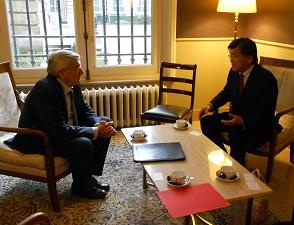
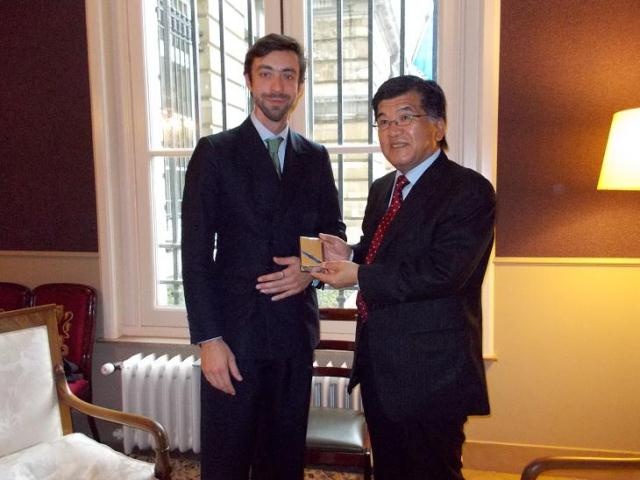 There are parliamentary friendship unions with the aim to promote friendly relations with individual foreign countries in each country’s parliament. In the case of the Belgian federal parliament, these parliamentary friendship unions are well organized and there’s a union for almost each country in the world, including Japan. Senator Etienne Schouppe recently assumed the office of president of the parliamentary friendship union with Japan, for the previous president, Senator Rik Torfs became rector of the KUL. I paid a courtesy call to the new president about 10 days ago and had an informal talk with him. I was surprised at his opening words, saying: “I am not a politician”. In fact, he has held major jobs in the field of railways and has been the President of the National Railways Corporation in Belgium and the President of the International Union of Railways. He visited Japan about 20 years ago, upon invitation of the East Japan Railway Company. During my visit, Vice-president of the Union Mr. Willem-Frederik Schiltz of the House of Representatives accompanied us. He is a 34-year old young politician who holds the license of lawyer. His father was once vice prime minister and he himself already has been a member of parliament for over six years. He is now the president of the Nuclear Safety Subcommittee of the House of Representatives and he is interested in the nuclear accident in Fukushima. I am glad that the Belgian parliamentary friendship union towards Japan is well organized. The problem however, is that on the Japanese side, the organization of the Parliamentary Friendship Union for Belgium is unclear. Therefore, I hope that a framework can be put in place very soon at the Japanese side in order to promote parliamentary exchanges a lot. There are parliamentary friendship unions with the aim to promote friendly relations with individual foreign countries in each country’s parliament. In the case of the Belgian federal parliament, these parliamentary friendship unions are well organized and there’s a union for almost each country in the world, including Japan. Senator Etienne Schouppe recently assumed the office of president of the parliamentary friendship union with Japan, for the previous president, Senator Rik Torfs became rector of the KUL. I paid a courtesy call to the new president about 10 days ago and had an informal talk with him. I was surprised at his opening words, saying: “I am not a politician”. In fact, he has held major jobs in the field of railways and has been the President of the National Railways Corporation in Belgium and the President of the International Union of Railways. He visited Japan about 20 years ago, upon invitation of the East Japan Railway Company. During my visit, Vice-president of the Union Mr. Willem-Frederik Schiltz of the House of Representatives accompanied us. He is a 34-year old young politician who holds the license of lawyer. His father was once vice prime minister and he himself already has been a member of parliament for over six years. He is now the president of the Nuclear Safety Subcommittee of the House of Representatives and he is interested in the nuclear accident in Fukushima. I am glad that the Belgian parliamentary friendship union towards Japan is well organized. The problem however, is that on the Japanese side, the organization of the Parliamentary Friendship Union for Belgium is unclear. Therefore, I hope that a framework can be put in place very soon at the Japanese side in order to promote parliamentary exchanges a lot.
< Luxemburg: the Largest, but also the Least Populated Province >
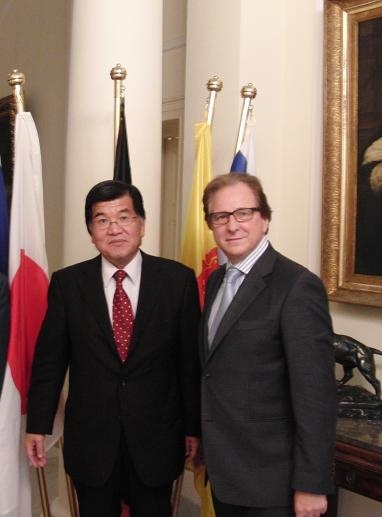 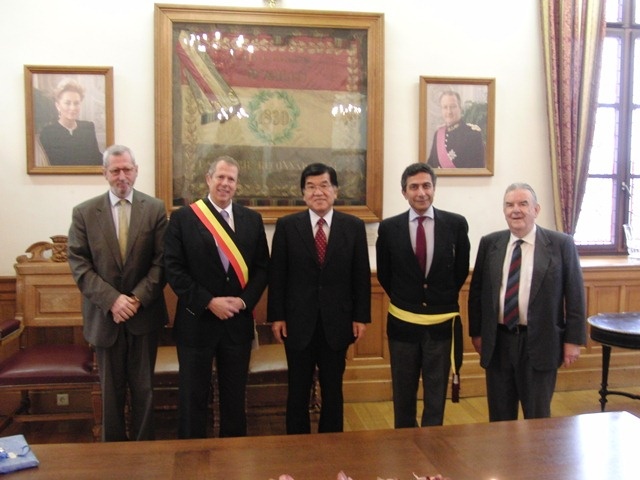 Last week, I officially visited the province of Luxemburg which is the largest (4440 km2), but also the least populated. Brussels to this province is about 190 km and it takes about 2 hours by car to Arlon, the capital of the province. With 28.000 inhabitants it is the smallest amongst the ten provincial capitals of Belgium. The province of Luxemburg was established in 1839, nine years after Belgium’s independence. The province of Luxemburg separated from The Grand Duchy of Luxembourg and was incorporated into Belgium. The history of this period is very complicated. According to Bernard CAPRASSE, who has been the governor for eighteen years, this province which was called for a long time the “agriculture and forestry country”, gradually changed to the “country of advanced technologies” and is considered one of the rich provinces of Belgium. As Luxemburg borders to France, the number of French people living in France but working in Luxemburg is around 6000. On the other hand, the number of people living in the province of Luxemburg but working in the Grand Duchy of Luxemburg is around 30.000. What is interesting is that the French pay their income taxes to France where they live, but the people from the province of Luxemburg pay their income tax to the Grand Duchy of Luxemburg where they work. This is because of the high taxation in Belgium. For this reason, the province of Luxemburg gets a refund of part of the income tax paid by its residents according to an agreement with The Grand Duchy of Luxembourg. Regarding the city of Arlon, the mayor Mr Vincent Magnus told me that the number of immigrants, such as Chechens, is increasing in the city. Therefore the harmonization between people with different birth places and religions is one of the challenges. We were accompanied at the meeting by Mr Patrick Nothomb, former Belgian Ambassador to Japan, who lives near Arlon since his retirement. Last week, I officially visited the province of Luxemburg which is the largest (4440 km2), but also the least populated. Brussels to this province is about 190 km and it takes about 2 hours by car to Arlon, the capital of the province. With 28.000 inhabitants it is the smallest amongst the ten provincial capitals of Belgium. The province of Luxemburg was established in 1839, nine years after Belgium’s independence. The province of Luxemburg separated from The Grand Duchy of Luxembourg and was incorporated into Belgium. The history of this period is very complicated. According to Bernard CAPRASSE, who has been the governor for eighteen years, this province which was called for a long time the “agriculture and forestry country”, gradually changed to the “country of advanced technologies” and is considered one of the rich provinces of Belgium. As Luxemburg borders to France, the number of French people living in France but working in Luxemburg is around 6000. On the other hand, the number of people living in the province of Luxemburg but working in the Grand Duchy of Luxemburg is around 30.000. What is interesting is that the French pay their income taxes to France where they live, but the people from the province of Luxemburg pay their income tax to the Grand Duchy of Luxemburg where they work. This is because of the high taxation in Belgium. For this reason, the province of Luxemburg gets a refund of part of the income tax paid by its residents according to an agreement with The Grand Duchy of Luxembourg. Regarding the city of Arlon, the mayor Mr Vincent Magnus told me that the number of immigrants, such as Chechens, is increasing in the city. Therefore the harmonization between people with different birth places and religions is one of the challenges. We were accompanied at the meeting by Mr Patrick Nothomb, former Belgian Ambassador to Japan, who lives near Arlon since his retirement.
< A Half Day with the Governor of Namur >
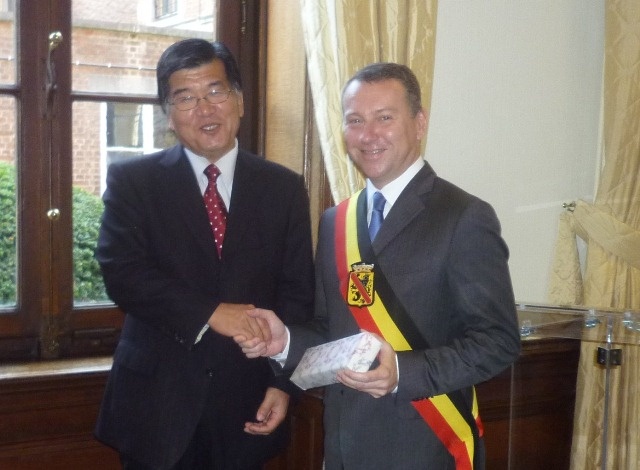
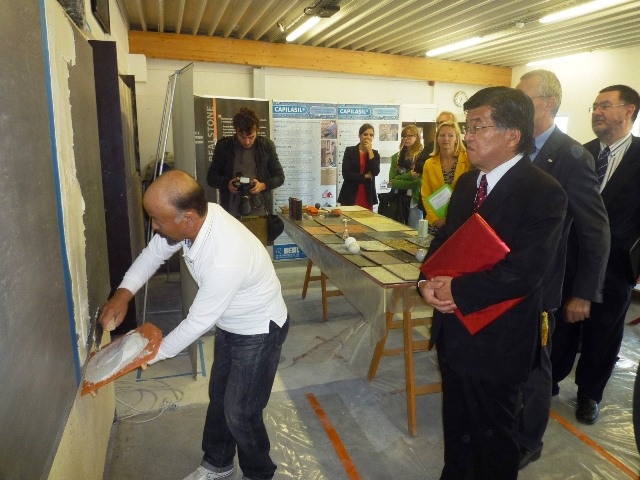 The other day, I was invited by Mr. Denis Matten, the Governor of Namur and I spent about half a day with him: I visited companies and had a meeting with the people of the companies of the region. After that, I had lunch and in the end I visited a museum as well. The first company I visited was BEAL which produces plaster. It is a small company with eighteen employees, family-run, with a history of close to 40 years. The company exports a product called “Mortex” abroad and strongly hopes to expand its sales to Japan. When I visited, I was accompanied by the president of a company located in Tokyo that does specific plaster work and a plasterer from Awaji Island in Japan. They valued “Mortex” highly, for its high waterproofness and adhesiveness. After that, at the meeting with companies’ representatives held at the governor’s office, I met with various people, from a signboard maker and an internet advertiser to a small local beer producer. What was especially interesting was the company called “Cardiatis” which produces stents used for the treatment of cardiac aneurysms. Though it only has a history of 10 years, it employs 40 people and exports the product to Europe and North America. It is considering a collaboration with Japanese companies and hires a Japanese patent attorney for this purpose this year. The last visit to the museum was to see orfevrerie pieces of the famous Hugo d’Oignies, which was my strong desire. The splendour and accuracy of the gold and silver works by Hugo d’Oignies in the beginning of the 13 century is astounding. It is counted as one of the “seven treasures” of Belgium. Several attempts of theft have occurred in the past. Whenever that happened, the works were secretly kept in the basement of a nearby local church and abbey. The city of Namur which developed on the convergence point between the rivers Meuse and Sambre, makes for a beautiful scenery. Namur has become one of my favourite cities. The other day, I was invited by Mr. Denis Matten, the Governor of Namur and I spent about half a day with him: I visited companies and had a meeting with the people of the companies of the region. After that, I had lunch and in the end I visited a museum as well. The first company I visited was BEAL which produces plaster. It is a small company with eighteen employees, family-run, with a history of close to 40 years. The company exports a product called “Mortex” abroad and strongly hopes to expand its sales to Japan. When I visited, I was accompanied by the president of a company located in Tokyo that does specific plaster work and a plasterer from Awaji Island in Japan. They valued “Mortex” highly, for its high waterproofness and adhesiveness. After that, at the meeting with companies’ representatives held at the governor’s office, I met with various people, from a signboard maker and an internet advertiser to a small local beer producer. What was especially interesting was the company called “Cardiatis” which produces stents used for the treatment of cardiac aneurysms. Though it only has a history of 10 years, it employs 40 people and exports the product to Europe and North America. It is considering a collaboration with Japanese companies and hires a Japanese patent attorney for this purpose this year. The last visit to the museum was to see orfevrerie pieces of the famous Hugo d’Oignies, which was my strong desire. The splendour and accuracy of the gold and silver works by Hugo d’Oignies in the beginning of the 13 century is astounding. It is counted as one of the “seven treasures” of Belgium. Several attempts of theft have occurred in the past. Whenever that happened, the works were secretly kept in the basement of a nearby local church and abbey. The city of Namur which developed on the convergence point between the rivers Meuse and Sambre, makes for a beautiful scenery. Namur has become one of my favourite cities.
< The Lecture at Antwerp University >
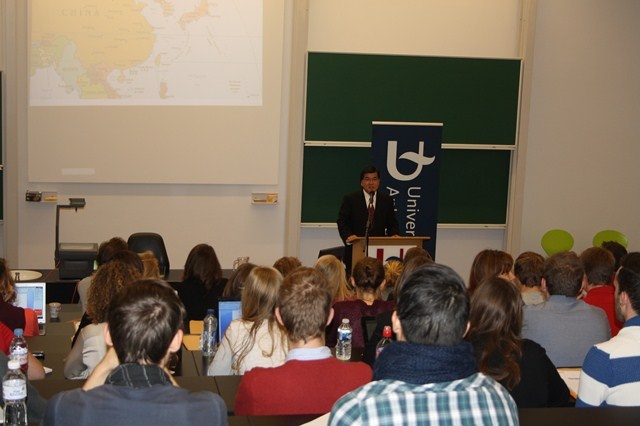 The other day, I visited Antwerp University for the first time and gave a lecture on the theme of “Japan: Today and Tomorrow” in front of about a 100 students. Although it seemed that most of the students were master students, I tried my best to convey the subject as intelligibly as possible, as the assistant professor explained to me in advance that the knowledge of Japan by the students was rather lacking. I began by touching upon the history of a Jesuit springing forth from Antwerp in 1620, who came to Japan in missionary work. After that I talked about Japanese life in the 1960’s (related to the film “Always, Sunset on Third Street” set to be shown that afternoon). This was a very nostalgic, “good-old-days” period for those who are now around 64 to 67 years old (the so called “baby boom generation”). The 1960’s saw the end of the reconstruction after WW II, and started to move to an era of rapid growth. The whole of Japan was still poor, but the ties between people were strong and it was an era full of hope. However, after about twenty years of rapid growth, long economic stagnation has continued until this day. In this age of materialism, the gap between rich and poor expands and a vague discontent piles up. The aging of society continues and maintaining the pension system is more difficult. Under these circumstances the Abe administration came to power end of last year and, starting with an economic policy called “Abenomics”, the administration has been announcing one new policy after the other. As a result, we can feel that the Japanese society becomes a little more active again. I finally explained the long term energy policy and how to tackle the aging society as some of the challenges Japan faces for the future, but I am not confident that the students understood them. The other day, I visited Antwerp University for the first time and gave a lecture on the theme of “Japan: Today and Tomorrow” in front of about a 100 students. Although it seemed that most of the students were master students, I tried my best to convey the subject as intelligibly as possible, as the assistant professor explained to me in advance that the knowledge of Japan by the students was rather lacking. I began by touching upon the history of a Jesuit springing forth from Antwerp in 1620, who came to Japan in missionary work. After that I talked about Japanese life in the 1960’s (related to the film “Always, Sunset on Third Street” set to be shown that afternoon). This was a very nostalgic, “good-old-days” period for those who are now around 64 to 67 years old (the so called “baby boom generation”). The 1960’s saw the end of the reconstruction after WW II, and started to move to an era of rapid growth. The whole of Japan was still poor, but the ties between people were strong and it was an era full of hope. However, after about twenty years of rapid growth, long economic stagnation has continued until this day. In this age of materialism, the gap between rich and poor expands and a vague discontent piles up. The aging of society continues and maintaining the pension system is more difficult. Under these circumstances the Abe administration came to power end of last year and, starting with an economic policy called “Abenomics”, the administration has been announcing one new policy after the other. As a result, we can feel that the Japanese society becomes a little more active again. I finally explained the long term energy policy and how to tackle the aging society as some of the challenges Japan faces for the future, but I am not confident that the students understood them.
< Exhibition of a Japanese Painter >
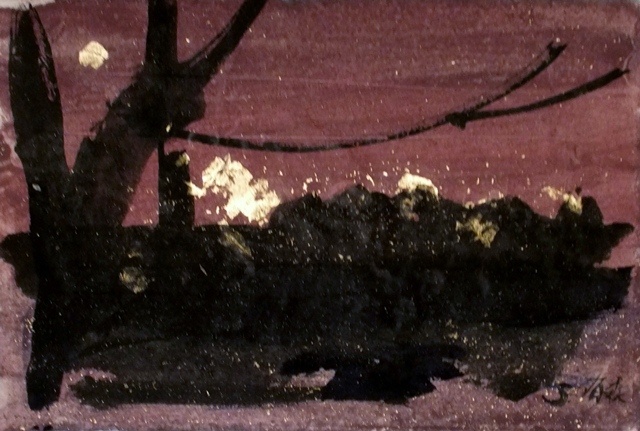 An exhibition of a Japanese painter is currently being held at the Museum of Art in Herentals (70 km northeast of Brussels: 27.000 inhabitants). The name of the painter is Mr. Sei Arimori and he has lived in Tournai (85 km southwest of Brussels) since about five years. He paints many abstract pieces. I was invited to the vernissage about ten days ago and saw about sixty pieces. The art museum, which was previously a windmill for grinding flour, has been renovated into a modern interior and exterior, and thus a great match with Arimori’s pieces. There were no sketches in his pieces to be seen. The reason for this was that the pieces were to be enjoyed on their colour mixture, with a colour scheme of gold and navy blue, and dark browns rather than representational paintings. Gazing upon them for a while, I started to feel relaxed. The person who introduced Mr Arimori to me was the wife of Mr Rudy Demotte, Minister-President of the Walloon Region and she is strongly interested in Japan. At the vernissage of that day, about a 100 people, mainly painting lovers attended, despite the fact that it was held in a local city on an evening of a regular weekday. As the exposition will continue until December, I hope that many people will go and see it. An exhibition of a Japanese painter is currently being held at the Museum of Art in Herentals (70 km northeast of Brussels: 27.000 inhabitants). The name of the painter is Mr. Sei Arimori and he has lived in Tournai (85 km southwest of Brussels) since about five years. He paints many abstract pieces. I was invited to the vernissage about ten days ago and saw about sixty pieces. The art museum, which was previously a windmill for grinding flour, has been renovated into a modern interior and exterior, and thus a great match with Arimori’s pieces. There were no sketches in his pieces to be seen. The reason for this was that the pieces were to be enjoyed on their colour mixture, with a colour scheme of gold and navy blue, and dark browns rather than representational paintings. Gazing upon them for a while, I started to feel relaxed. The person who introduced Mr Arimori to me was the wife of Mr Rudy Demotte, Minister-President of the Walloon Region and she is strongly interested in Japan. At the vernissage of that day, about a 100 people, mainly painting lovers attended, despite the fact that it was held in a local city on an evening of a regular weekday. As the exposition will continue until December, I hope that many people will go and see it.
|